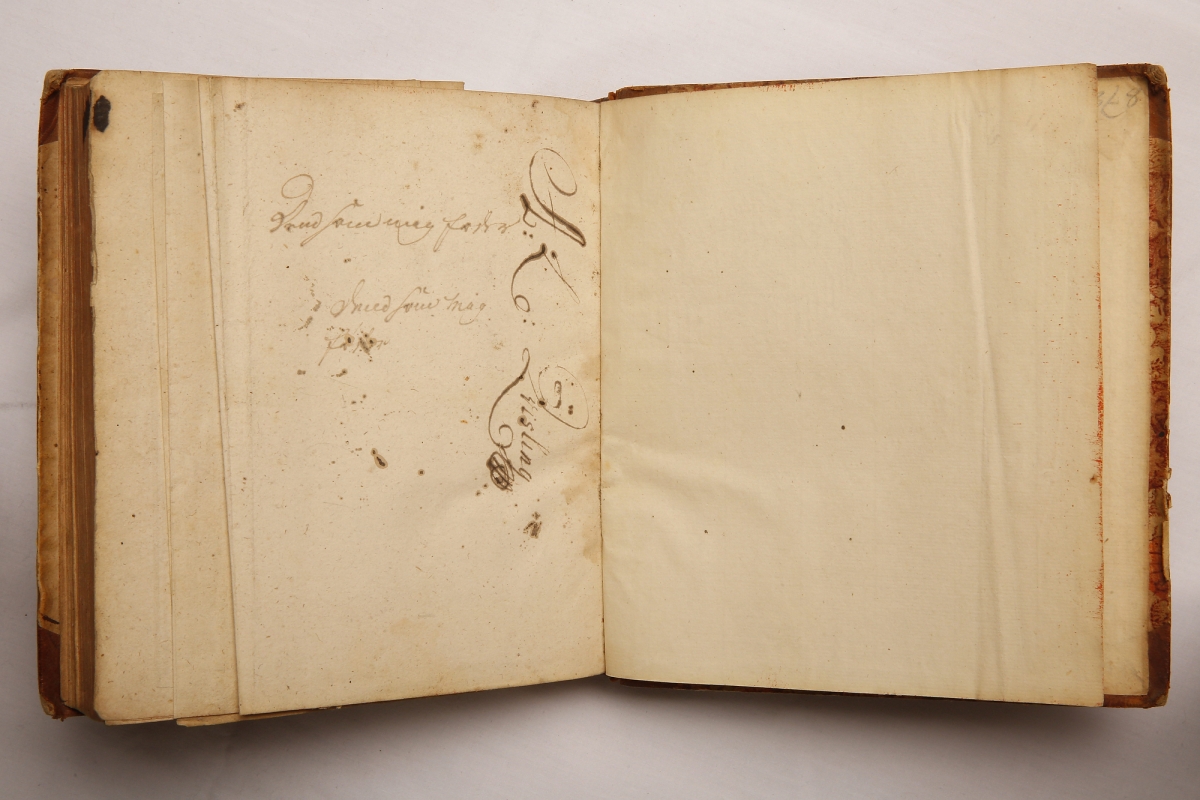- About MAA
- Membership
- MAA Publications
- Periodicals
- Blogs
- MAA Book Series
- MAA Press (an imprint of the AMS)
- MAA Notes
- MAA Reviews
- Mathematical Communication
- Information for Libraries
- Author Resources
- Advertise with MAA
- Meetings
- Competitions
- Programs
- Communities
- MAA Sections
- SIGMAA
- MAA Connect
- Students
- MAA Awards
- Awards Booklets
- Writing Awards
- Teaching Awards
- Service Awards
- Research Awards
- Lecture Awards
- Putnam Competition Individual and Team Winners
- D. E. Shaw Group AMC 8 Awards & Certificates
- Maryam Mirzakhani AMC 10 A Awards & Certificates
- Two Sigma AMC 10 B Awards & Certificates
- Jane Street AMC 12 A Awards & Certificates
- Akamai AMC 12 B Awards & Certificates
- High School Teachers
- News
You are here
E. G. Ziegenbalg’s Danish Translation of Euclid’s Elements: Provenance of This Copy
The ownership history of the author’s copy of Ziegenbalg’s translation of the Elements is of interest and worth sharing here. An inscription at the beginning of the book shows that it belonged to a P. L. Quisling in 1747 (look above the book title in Figure 1).
Quisling is a Norwegian family name that traces its origin to Lauritz Ibsen Quislin (1634–1703), who as a young man moved to Norway from Kvislemark in Denmark.[14] The name Quisling derives from the placename Kvislemark. Through the generations, many members of the family became pastors. Today, the name Quisling is inextricably linked to Vidkun Quisling (1887–1945), a Norwegian politician and Nazi collaborator, who was executed in 1945 after the end of World War II. Even during Vidkun Quisling’s lifetime, the term “quisling” was used in English to mean a traitor or collaborator.
P. L. Quisling is probably Peder Larsson Qvislin, one of the sons of the pastor Lauritz Abrahamsson Qvislin (d. 1756).[15] In 1748, at the age of 21, Peder matriculated at the University of Copenhagen, where he is listed as Petrus Quislin [Birket-Smith 1912, 84].
An inscription on the back of the last fold-out plate in the book provides another name: A. L. Quisling (see Figure 10). A. L. Quisling was probably Peder’s younger brother Abraham Larsson Qvislin. In 1749, also at the age of 21, Abraham matriculated at the University of Copenhagen, where he is listed as Abrahamus Quislin [Birket-Smith 1912, 95]. The brothers’ sister Susanne was the great-great-grandmother of Vidkun Quisling.
It has been generally accepted that Lars Abraham Qvisling (1816–1876), the grandfather of Vidkun Quisling, was the first to add a final "g" to the name Qvislin [Ormtveit 1993, 9 and 37]. However, the two inscriptions in the author’s book by earlier members of the Quisling family show that a final "g" was used much earlier than that.
A third inscription shows that the book belonged to a Jørres Schjelderup Hansen in 1832 (see the top right corner of the left-hand page in Figure 1), which must be the Norwegian pastor and politician Jørres Schjelderup Hansen (1811–1870) [Lindstøl 1914, 339].
The line Dend som mig føder, “The one who births me,” is written twice next to (and perpendicular to) the name A. L. Quisling (see Figure 10). The line, which is the beginning of a hymn, was at the time commonly used as a pen trial (probatio pennae). That is, the line was commonly written when people were testing a new pen (much like the urban legend that guitarists play “Smoke on the Water” when trying out a new guitar). In fact, the Danish-Norwegian playwright Ludvig Holberg (1684–1754) mentions the line as a pen trial in the comedy Uden hoved og hale (Without Head or Tail) from 1723 [Holberg 1897–1909, vi:139]. In other words, the repetition of the line simply indicates that someone, perhaps Abraham Larsson Qvislin, was testing a pen before starting to write.[16]
Some marginal notes and underlining of words in the text are found only in Book 1 and in Proposition 2.6. The rest of the book appears to be unused, consistent with Christensen’s comment that students back then hardly would have gotten through more than Book 1 due to time constraints [Christensen 1895, 41]. Similarly, Cajori [1924, 137] notes that in medieval Europe, examinations in mathematics—if held at all—probably did not extend beyond Book 1 of the Elements. For that reason, the Pythagorean theorem, which with its converse concludes Book 1, was nicknamed Magister Matheseos (Master of Mathematics).
Figure 10. Inscription with the name A. L. Qvisling and the line Dend som mig føder, the latter written twice.
[14] For the Quisling family, see the wiki page maintained by the Norwegian Institute of Local History at the National Library of Norway at https://lokalhistoriewiki.no/wiki/Quisling (accessed 29 August 2021). See also [Ormtveit 1993].
[15] For information about Lauritz Qvislin and his children, see [Ormtveit 1993, 29–30].
[16] For an extensive discussion of the line Dend som mig føder, see [Frederiksen 2001].
Toke Lindegaard Knudsen (State University of New York at Oneonta), "E. G. Ziegenbalg’s Danish Translation of Euclid’s Elements: Provenance of This Copy," Convergence (October 2021)





